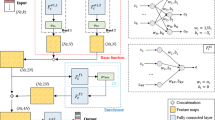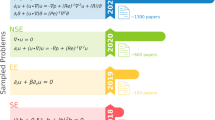Abstract
Physics-informed neural networks (PINNs) are an emerging method for solving partial differential equations (PDEs) and have been widely applied in the field of scientific computing. In this paper, we introduce a novel adaptive PINN model for solving PDEs. The model draws on the idea of traditional adaptive methods and incorporates the adaptive collocation point movement method into the PINNs model. It can use residual information from the PDE or characteristics of the solution function itself to guide the movement of collocation points, giving an appropriate distribution of collocation points for specific problems, improving the predictive accuracy of the model, and avoiding overfitting. Additionally, the model introduces an adaptive loss weighting strategy, which updates adaptive weights continuously by minimizing negative log-likelihood estimation to achieve adaptive weighting of the loss function, thereby improving the convergence rate and accuracy of the model. Finally, we conduct extensive experiments, including the one-dimensional Poisson equation, two-dimensional Poisson equation, Burgers equation, Klein–Gordon equation, Helmholtz equation, and Lid-Driven problem, to demonstrate the effectiveness and accuracy of the proposed model. The experimental results show that the model can significantly improve predictive accuracy and generalization ability. The data and code can be found at https://github.com/hsbhc/AMAW-PINN.

























Similar content being viewed by others
Data availability
The data and code can be found at https://github.com/hsbhc/AMAW-PINN.
References
Renardy, M., Rogers, R.C.: An Introduction to Partial Differential Equations, vol. 13. Springer, New York (2006)
Strauss, W.A.: Partial Differential Equations: An Introduction. John Wiley & Sons, Hoboken (2007)
Ricardo, H.J.: A Modern Introduction to Differential Equations. Academic Press, London (2020)
Murray, J.D.: Mathematical Biology: I. An Introduction. Springer, New York (2002)
Mészáros, P., Fox, D.B., Hanna, C., Murase, K.: Multi-messenger astrophysics. Nat. Rev. Phys. 1(10), 585–599 (2019)
Smolarkiewicz, P.K., Kühnlein, C., Wedi, N.P.: Semi-implicit integrations of perturbation equations for all-scale atmospheric dynamics. J. Comput. Phys. 376, 145–159 (2019)
Balla, C.S., Alluguvelli, R., Naikoti, K., Makinde, O.D.: Effect of chemical reaction on bioconvective flow in oxytactic microorganisms suspended porous cavity. J. Appl. Comput. Mech. 6(3), 653–664 (2020)
Lye, K.O., Mishra, S., Ray, D.: Deep learning observables in computational fluid dynamics. J. Comput. Phys. 410, 109339 (2020)
Markowich, P.: Applied Partial Differential Equations: A Visual Approach. Springer, New York (2007)
Zhang, Y.: A finite difference method for fractional partial differential equation. Appl. Math. Comput. 215(2), 524–529 (2009)
Taylor, C.A., Hughes, T.J., Zarins, C.K.: Finite element modeling of blood flow in arteries. Comput. Methods Appl. Mech. Eng. 158(1–2), 155–196 (1998)
Eymard, R., Gallouët, T., Herbin, R.: Finite volume methods. Handb. Num. Anal. 7, 713–1018 (2000)
LeCun, Y., Bengio, Y., Hinton, G.: Deep learning. Nature 521(7553), 436–444 (2015)
Krizhevsky, A., Sutskever, I., Hinton, G.E.: Imagenet classification with deep convolutional neural networks. Commun. ACM 60(6), 84–90 (2017)
Mikolov, T., Chen, K., Corrado, G., Dean, J.: Efficient Estimation of Word Representations in Vector Space. arXiv preprint arXiv:1301.3781 (2013)
Amodei, D., Ananthanarayanan, S., Anubhai, R., Bai, J., Battenberg, E., Case, C., Casper, J., Catanzaro, B., Cheng, Q., Chen, G., et al.: Deep speech 2: end-to-end speech recognition in english and mandarin. In: International Conference on Machine Learning, pp. 173–182 (2016). PMLR
Cai, X., Li, X., Razmjooy, N., Ghadimi, N., et al.: Breast cancer diagnosis by convolutional neural network and advanced thermal exchange optimization algorithm. In: Computational and Mathematical Methods in Medicine (2021)
Guo, Z., Xu, L., Si, Y., Razmjooy, N.: Novel computer-aided lung cancer detection based on convolutional neural network-based and feature-based classifiers using metaheuristics. Int. J. Imaging Syst. Technol. 31(4), 1954–1969 (2021)
Huang, Q., Ding, H., Razmjooy, N.: Optimal deep learning neural network using ISSA for diagnosing the oral cancer. Biomed. Signal Process. Control 84, 104749 (2023)
Raissi, M., Yazdani, A., Karniadakis, G.E.: Hidden fluid mechanics: learning velocity and pressure fields from flow visualizations. Science 367(6481), 1026–1030 (2020)
Lu, L., Meng, X., Mao, Z., Karniadakis, G.E.: DeepXDE: a deep learning library for solving differential equations. SIAM Rev. 63(1), 208–228 (2021)
Sirignano, J., Spiliopoulos, K.: DGM: a deep learning algorithm for solving partial differential equations. J. Comput. Phys. 375, 1339–1364 (2018)
Raissi, M., Perdikaris, P., Karniadakis, G.E.: Physics-informed neural networks: a deep learning framework for solving forward and inverse problems involving nonlinear partial differential equations. J. Comput. Phys. 378, 686–707 (2019)
Yuan, L., Ni, Y.-Q., Deng, X.-Y., Hao, S.: A-PINN: auxiliary physics informed neural networks for forward and inverse problems of nonlinear integro-differential equations. J. Comput. Phys. 462, 111260 (2022)
Yu, J., Lu, L., Meng, X., Karniadakis, G.E.: Gradient-enhanced physics-informed neural networks for forward and inverse PDE problems. Comput. Methods Appl. Mech. Eng. 393, 114823 (2022)
Lu, L., Jin, P., Pang, G., Zhang, Z., Karniadakis, G.E.: Learning nonlinear operators via DeepONet based on the universal approximation theorem of operators. Nat. Mach. Intell. 3(3), 218–229 (2021)
Wang, S., Wang, H., Perdikaris, P.: Learning the solution operator of parametric partial differential equations with physics-informed deeponets. Sci. Adv. 7(40), 8605 (2021)
Long, Z., Lu, Y., Dong, B.: PDE-Net 2.0: learning PDEs from data with a numeric-symbolic hybrid deep network. J. Comput. Phys. 399, 108925 (2019)
Bai, Y., Chaolu, T., Bilige, S.: Solving huxley equation using an improved PINN method. Nonlinear Dyn. 105(4), 3439–3450 (2021)
Wang, S., Teng, Y., Perdikaris, P.: Understanding and mitigating gradient flow pathologies in physics-informed neural networks. SIAM J. Sci. Comput. 43(5), 3055–3081 (2021)
Meng, X., Li, Z., Zhang, D., Karniadakis, G.E.: PPINN: parareal physics-informed neural network for time-dependent PDEs. Comput. Methods Appl. Mech. Eng. 370, 113250 (2020)
Pang, G., D’Elia, M., Parks, M., Karniadakis, G.E.: nPINNs: nonlocal Physics-Informed Neural Networks for a parametrized nonlocal universal Laplacian operator. Algorithms and Applications. J. Comput. Phys. 422, 109760 (2020)
Jagtap, A.D., Kawaguchi, K., Karniadakis, G.E.: Adaptive activation functions accelerate convergence in deep and physics-informed neural networks. J. Comput. Phys. 404, 109136 (2020)
Li, Y., Xu, L., Ying, S.: Dwnn: deep wavelet neural network for solving partial differential equations. Mathematics 10(12), 1976 (2022)
Chen, M., Niu, R., Zheng, W.: Adaptive multi-scale neural network with resnet blocks for solving partial differential equations. Nonlinear Dyn. 111(7), 6499–6518 (2023)
Yue, J., Li, J.: The physics informed neural networks for the unsteady Stokes problems. Int. J. Num. Methods Fluids 94(9), 1416–1433 (2022)
Pang, G., Lu, L., Karniadakis, G.E.: fPINNs: fractional physics-informed neural networks. SIAM J. Sci. Comput. 41(4), 2603–2626 (2019)
Han, J., Jentzen, A., et al.: Deep learning-based numerical methods for high-dimensional parabolic partial differential equations and backward stochastic differential equations. Commun. Math. Stat. 5(4), 349–380 (2017)
Lyu, L., Zhang, Z., Chen, M., Chen, J.: MIM: a deep mixed residual method for solving high-order partial differential equations. J. Comput. Phys. 452, 110930 (2022)
Jin, X., Cai, S., Li, H., Karniadakis, G.E.: NSFnets (Navier-Stokes flow nets): physics-informed neural networks for the incompressible Navier–Stokes equations. J. Comput. Phys. 426, 109951 (2021)
Jiang, X., Wang, D., Fan, Q., Zhang, M., Lu, C., Lau, A.P.T.: Physics-informed neural network for nonlinear dynamics in fiber optics. Laser Photon. Rev. 16(9), 2100483 (2022)
Cai, S., Wang, Z., Wang, S., Perdikaris, P., Karniadakis, G.E.: Physics-informed neural networks for heat transfer problems. J. Heat Transf. 143, 6 (2021)
Raymond, S.J., Cecchi, N.J., Alizadeh, H.V., Callan, A.A., Rice, E., Liu, Y., Zhou, Z., Zeineh, M., Camarillo, D.B.: Physics-informed machine learning improves detection of head impacts. Ann. Biomed. Eng. 1, 12 (2022)
Zheng, Q., Zeng, L., Karniadakis, G.E.: Physics-informed semantic inpainting: application to geostatistical modeling. J. Comput. Phys. 419, 109676 (2020)
Bai, Y., Chaolu, T., Bilige, S.: The application of improved physics-informed neural network (IPINN) method in finance. Nonlinear Dyn. 107(4), 3655–3667 (2022)
Wen, X.-K., Wu, G.-Z., Liu, W., Dai, C.-Q.: Dynamics of diverse data-driven solitons for the three-component coupled nonlinear schrödinger model by the MPS-PINN method. Nonlinear Dyn. 109(4), 3041–3050 (2022)
Karniadakis, G.E., Kevrekidis, I.G., Lu, L., Perdikaris, P., Wang, S., Yang, L.: Physics-informed machine learning. Nat. Rev. Phys. 3(6), 422–440 (2021)
Chiu, P.-H., Wong, J.C., Ooi, C., Dao, M.H., Ong, Y.-S.: CAN-PINN: a fast physics-informed neural network based on coupled-automatic-numerical differentiation method. Comput. Methods Appl. Mech. Eng. 395, 114909 (2022)
Wu, C., Zhu, M., Tan, Q., Kartha, Y., Lu, L.: A comprehensive study of non-adaptive and residual-based adaptive sampling for physics-informed neural networks. Comput. Methods Appl. Mech. Eng. 403, 115671 (2023)
Nabian, M.A., Gladstone, R.J., Meidani, H.: Efficient training of physics-informed neural networks via importance sampling. Computer-Aided Civil Infrastr. Eng. 36(8), 962–977 (2021)
Daw, A., Bu, J., Wang, S., Perdikaris, P., Karpatne, A.: Rethinking the Importance of Sampling in Physics-Informed Neural Networks. arXiv preprint arXiv:2207.02338 (2022)
Gao, W., Wang, C.: Active learning based sampling for high-dimensional nonlinear partial differential equations. J. Comput. Phys. 475, 111848 (2023)
Tang, K., Wan, X., Yang, C.: DAS-PINNs: a deep adaptive sampling method for solving high-dimensional partial differential equations. J. Comput. Phys. 476, 111868 (2023)
Zeng, S., Zhang, Z., Zou, Q.: Adaptive deep neural networks methods for high-dimensional partial differential equations. J. Comput. Phys. 463, 111232 (2022)
Hanna, J.M., Aguado, J.V., Comas-Cardona, S., Askri, R., Borzacchiello, D.: Residual-based adaptivity for two-phase flow simulation in porous media using Physics-informed Neural Networks. Comput. Methods Appl. Mech. Eng. 396, 115100 (2022)
Zhang, W., Almgren, A., Beckner, V., Bell, J., Blaschke, J., Chan, C., Day, M., Friesen, B., Gott, K., Graves, D., et al.: Amrex: a framework for block-structured adaptive mesh refinement. J. Open Sourc. Softw. 4(37), 1370–1370 (2019)
Berger, M.J., Oliger, J.: Adaptive mesh refinement for hyperbolic partial differential equations. J. Comput. Phys. 53(3), 484–512 (1984)
Díez, P., Huerta, A.: A unified approach to remeshing strategies for finite element h-adaptivity. Comput. Methods Appl. Mech. Eng. 176(1–4), 215–229 (1999)
McClenny, L., Braga-Neto, U.: Self-adaptive Physics-Informed Neural Networks Using a Soft Attention Mechanism. arXiv preprint arXiv:2009.04544 (2020)
Xiang, Z., Peng, W., Liu, X., Yao, W.: Self-adaptive loss balanced physics-informed neural networks. Neurocomputing 496, 11–34 (2022)
Kendall, A., Gal, Y., Cipolla, R.: Multi-task learning using uncertainty to weigh losses for scene geometry and semantics. In: Proceedings of the IEEE Conference on Computer Vision and Pattern Recognition, pp. 7482–7491 (2018)
Subramanian, S., Kirby, R.M., Mahoney, M.W., Gholami, A.: Adaptive Self-Supervision Algorithms for Physics-Informed Neural Networks. arXiv preprint arXiv:2207.04084 (2022)
Mao, Z., Jagtap, A.D., Karniadakis, G.E.: Physics-informed neural networks for high-speed flows. Comput. Methods Appl. Mech. Eng. 360, 112789 (2020)
Bateman, H.: Some recent researches on the motion of fluids. Monthly Weather Rev. 43(4), 163–170 (1915)
Basdevant, C., Deville, M., Haldenwang, P., Lacroix, J., Ouazzani, J., Peyret, R., Orlandi, P., Patera, A.: Spectral and finite difference solutions of the Burgers equation. Comput. Fluids 14(1), 23–41 (1986)
Wazwaz, A.-M.: New travelling wave solutions to the Boussinesq and the Klein–Gordon equations. Commun. Nonlinear Sci. Numer. Simulat. 13(5), 889–901 (2008)
Caudrey, P., Eilbeck, J., Gibbon, J.: The sine-Gordon equation as a model classical field theory. Il Nuovo Cimento B 25(2), 497–512 (1975)
Nédélec, J.-C.: Acoustic and Electromagnetic Equations: Integral Representations for Harmonic Problems, vol. 144. Springer, New York (2001)
Bruneau, C.-H., Saad, M.: The 2D lid-driven cavity problem revisited. Comput. Fluids 35(3), 326–348 (2006)
Funding
This work is supported by the National Key Research and Development Program of China (No. 2021YFA1003004).
Author information
Authors and Affiliations
Contributions
All authors contributed to the study conception and design. The experiments, data collection, and analysis were performed by JH. The first draft of the manuscript was written by JH, and all authors commented on previous versions of the manuscript. All authors read and approved the final manuscript.
Corresponding author
Ethics declarations
Comnflict of interests
The authors declare that there is no conflict of interest regarding the publication of this paper.
Additional information
Publisher's Note
Springer Nature remains neutral with regard to jurisdictional claims in published maps and institutional affiliations.
Rights and permissions
Springer Nature or its licensor (e.g. a society or other partner) holds exclusive rights to this article under a publishing agreement with the author(s) or other rightsholder(s); author self-archiving of the accepted manuscript version of this article is solely governed by the terms of such publishing agreement and applicable law.
About this article
Cite this article
Hou, J., Li, Y. & Ying, S. Enhancing PINNs for solving PDEs via adaptive collocation point movement and adaptive loss weighting. Nonlinear Dyn 111, 15233–15261 (2023). https://doi.org/10.1007/s11071-023-08654-w
Received:
Accepted:
Published:
Issue Date:
DOI: https://doi.org/10.1007/s11071-023-08654-w




